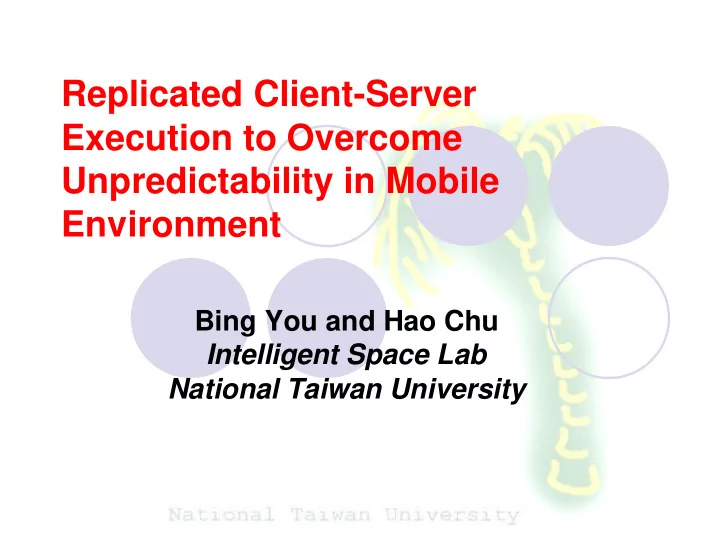

Replicated Client-Server Execution to Overcome Unpredictability in Mobile Environment Bing You and Hao Chu Intelligent Space Lab National Taiwan University
Outline � Problem � Related Work � Replicated Client-Server Model � Experiments � Implementation � Conclusion
Problem � Dynamic factors in mobile environment that affect response time � Wireless network bandwidth � Server loads � Usage patterns � The optimal client thickness (application partition) depends on these dynamic factors.
Problem Scenario Location A Location B
Related work � Adaptation methods � Chroma from CMU Replets from NTT DoCoMo USA Lab Agilos from UIUC � Based on a closed control loop to runtime repartition the application between client and server. � Resource monitor � Resource prediction � Application reconfiguration
Related work (cont’) Location A Location B 6H U Y H UV L G H � SU R FH V V 5 H T X H V W
Related work (cont’) � Major limitation of adaptation methods � Require predictable resources � What happen if resources are unpredictable? � Frequent application reconfigurations � Each reconfiguration incurs computing overheads. � Incorrect reconfiguration � Poor response time
Replicated Client-Server Model � How to get good response time under unpredictable resources without app reconfiguration? � Replicated client-server model
The best of thin and thick client models Replicated client-server model (cont’)
Replicated Client-Server Model vs. Adaptation Methods � Use replication to solve unpredictability. � No need to reconfigure under changing resource conditions � Give good response time under unpredictable resources
Experiment Setup � Using a component-based sample J2EE application to show the impact of changing resource conditions and usage patterns on application response time
Impact of usage patterns on response time � two possible usage patterns when a user views his/her shopping cart � No sign-on: views his/her shopping cart prior to sign-on. � After sign-on: views his/her shopping cart after sign-on. � Different usage patterns can change the optimal application partition . Response time Usage Thick Client Thin Client Patterns Partition Partition No sign-on 2.489 s 9.016 s After sign-on 45.065 s 11.241 s
Impact of network bandwidth on response time � Handoff between WLAN and GPRS network � Varying the network bandwidth can change the optimal application partition . Response time Network Thick Client Thin Client Bandwidth Partition Partition 2.489 s 9.016 s GPRS 2.987 s 0.614 s WLAN
Implementation and evaluation � A preliminary implementation on HP ipaq � request dispatcher, computation coordinator, database access interceptor and application-level session state synchronization � show the system overhead in replicated execution. Response time Usage Thick Client Thin Client Replicated Patterns Partition Partition Execution (Overhead) No sign-on 3.1 s 13.1 s 5.5 s (2.4 s) After sign-on 17.3 s 15.0 s 18.6 s (3.6 s)
Conclusion � Unpredictability in mobile environment � The adaptive system may frequently reconfigure. � Replicated client-server model. � Give good response time (at a cost of replicated execution overhead) � Work well under resource unpredictability � Future work � Refine our implementation � Code download mechanism
Q & A
Recommend
More recommend